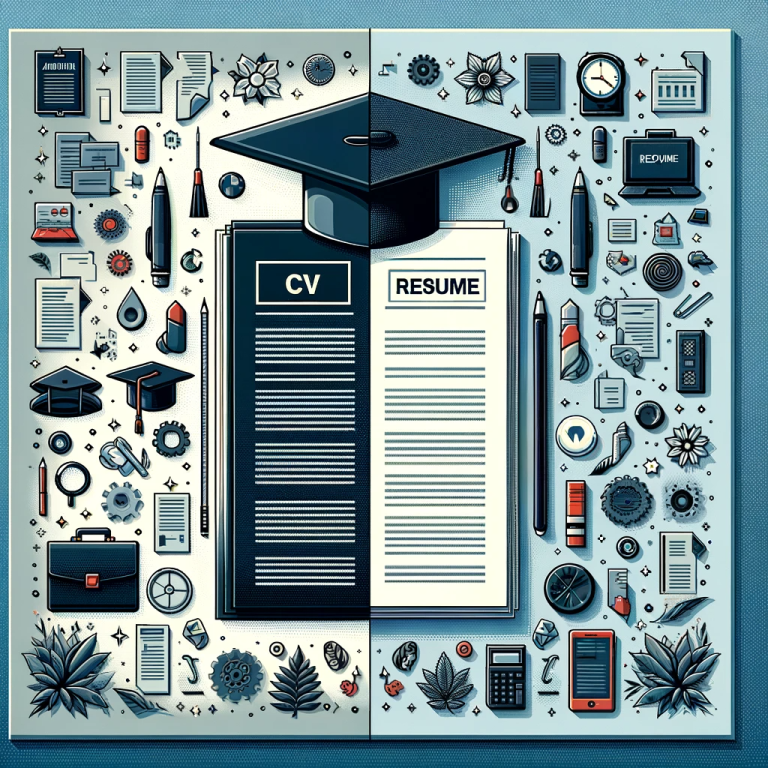How to Transition from Resume to CV [With Examples]
When it comes to job applications, understanding the difference between a resume and a Curriculum Vitae (CV) and knowing when to use each is crucial. A resume is typically a brief overview of your work experience and skills tailored to a specific job, while a CV is a comprehensive document detailing your entire career, including education, achievements, publications, and more. Transitioning from a resume to a CV can seem daunting, but with the right guidance and examples, you can create a document that showcases your professional journey effectively. This article will guide you through the process of transitioning from a resume to a CV, highlighting the differences, and providing tips and examples to help you along the way.
Understanding the Resume
A resume is a concise document, usually one to two pages long, designed to capture an employer’s interest quickly. It focuses on relevant work experience, skills, and education tailored to the job you’re applying for.

Understanding the CV
In contrast, a CV is a more detailed and comprehensive document. It covers your entire career, including academic and professional achievements, publications, awards, affiliations, and more. CVs are commonly used for academic, research, and some high-level positions, where detailed professional history is essential.
Differences Between a Resume and a CV
The main differences lie in length, content, focus, and geographical usage. Understanding these differences is crucial for transitioning effectively.
Preparing to Transition
Start by assessing your professional experience and gathering necessary documentation, such as educational records, certificates, and a list of publications, if applicable.
Transitioning Content
Expand your educational background details, include a comprehensive list of your academic and professional achievements, and incorporate sections for publications, presentations, and other relevant activities.
Formatting Your CV
Your CV should be well-structured and clearly formatted to make the information easy to find and read. Pay attention to the order of sections and the overall design.
Tips for a Successful Transition
Highlight transferable skills, tailor your CV to your field, and ensure consistency and clarity throughout the document to make your CV stand out.
Common Mistakes to Avoid
Avoid overloading your CV with too much information and neglecting the importance of formatting, as these can detract from the document’s effectiveness.
CV Examples
Example for Recent Graduates
Objective: A recent graduate aiming to enter a master’s program or an entry-level position in academia or research. The focus is on academic achievements, projects, and potential for future contribution.
Education:
- Bachelor of Science in Biology, XYZ University, 2023
- GPA: 3.8/4.0
- Honors: Cum Laude, Dean’s List (2021-2023)
- Thesis: “Impact of Climate Change on Coral Reefs” – Conducted comprehensive research on coral bleaching effects due to global warming, under the guidance of Prof. Jane Doe.
Research Experience:
- Undergraduate Research Assistant, Marine Biology Lab, XYZ University, 2022-2023
- Assisted in collecting and analyzing data on local marine ecosystems.
- Co-authored a paper on sustainable fishing practices in “Marine Ecology Today.”
Skills & Techniques:
- Proficient in statistical analysis using R and Python.
- Experienced in GIS mapping tools for environmental impact studies.
Extracurricular Activities:
- Member, XYZ University Environmental Club, 2021-2023
- Organized beach clean-up campaigns and environmental awareness workshops.
Example for Academics
Objective: An academic with several years of teaching and research experience looking to secure a faculty position or grant funding. The focus is on publications, teaching experience, and research contributions.
Education:
- Ph.D. in Environmental Science, ABC University, 2018
- Master of Science in Environmental Policy, DEF University, 2014
Teaching Experience:
- Assistant Professor, Department of Environmental Science, GHI University, 2019-Present
- Courses taught: Environmental Policy, Climate Change Mitigation Strategies
- Supervised 5 graduate theses on environmental sustainability.
Research Experience:
- Lead Researcher, Climate Resilience Initiative, GHI University, 2020-Present
- Secured $500,000 in grant funding for research on urban flood resilience.
Publications:
- Doe, J., & Smith, A. (2021). “Urban Flood Resilience in Coastal Cities.” Journal of Environmental Planning and Management, 64(5), 865-884.
Conference Presentations:
- “Innovative Urban Water Management Strategies,” International Conference on Sustainable Cities, 2022.
Example for Professionals Transitioning to Academia
Objective: A professional with extensive industry experience in technology looking to transition into an academic role, focusing on cybersecurity. The emphasis is on relevant professional experience, contributions to the field, and potential for teaching and research.
Education:
- Master of Science in Computer Science, Specialization in Cybersecurity, JKL University, 2015
- Bachelor of Science in Information Technology, MNO University, 2012
Professional Experience:
- Senior Cybersecurity Analyst, TechSolutions Inc., 2015-2023
- Led a team in developing innovative security protocols to protect against data breaches.
- Published several white papers on emerging cybersecurity threats and defenses.
Teaching Experience:
- Guest Lecturer, Cybersecurity Workshops, PQR University, 2020-2022
- Conducted workshops on cybersecurity best practices and emerging technologies.
Publications:
- “Emerging Threats in IoT Security,” White Paper, TechSolutions Inc., 2021.
Skills:
- Expertise in cybersecurity threat analysis, ethical hacking, and secure network design.
- Proficient in programming languages: Python, Java, and C++.
These examples illustrate how individuals can highlight their backgrounds and experiences in a CV format tailored to their specific goals, whether they are recent graduates, seasoned academics, or professionals seeking to enter academia.
FAQs
- What is the primary difference between a resume and a CV? The primary difference lies in the scope, length, and purpose of the two documents. A resume is a concise summary of your skills, experiences, and education tailored to a specific job, typically one to two pages long. A CV (Curriculum Vitae), on the other hand, is a comprehensive document detailing your entire career including academic background, teaching experience, degrees, research, publications, presentations, awards, honors, affiliations, and other academic achievements, with no page limit.
- How long should my CV be? The length of your CV can vary widely based on your professional and academic experiences. Unlike a resume, a CV is not restricted to one or two pages. It should be as long as it needs to be to include all relevant information about your academic and professional achievements. For early-career professionals, it might be shorter, but for those with extensive research, teaching, or publications, it can be much longer.
- What should I include in my CV if I’m transitioning from a non-academic to an academic career? If transitioning to academia, focus on adding sections that highlight your engagement with research, teaching, and scholarly publications. Include details of any research projects, academic conferences, workshops attended, courses taught, mentoring experience, and any publications or presentations. Even if your previous role was not in academia, include any tasks or projects that demonstrate relevant skills such as analytical thinking, project management, and communication.
- How can I make my CV stand out to employers? To make your CV stand out, ensure it is well-organized, clearly formatted, and tailored to the position or field you are applying to. Highlight your most relevant and significant achievements at the top. Use clear headings, bullet points for easy reading, and incorporate keywords from the job description or academic field. Showcasing unique contributions, such as impactful research or innovative teaching methods, can also distinguish your CV.
- Is it necessary to include publications in my CV if I’m not in academia? If you are applying for a position outside of academia, it’s not necessary to include a detailed list of publications unless they are directly relevant to the job. However, if you have any publications that demonstrate your expertise or skills relevant to the position, including them can add value to your CV. In such cases, a selective list of publications can highlight your writing skills, subject matter expertise, or ability to conduct research.
- Can I use the same CV for every job application? While the foundation of your CV will remain constant, it’s important to tailor it for each application, emphasizing the experience and qualifications most relevant to the specific position or academic field. Adjust your CV to highlight the aspects of your career that align with the job description or academic department’s focus. Tailoring your CV can significantly increase your chances of catching the attention of hiring committees or employers.
Conclusion
Transitioning from a resume to a CV requires a detailed understanding of the differences between the two documents and a careful consideration of your professional history. By following the guidelines and examples provided, you can create a compelling CV that accurately represents your career journey and achievements.
🔴Do you have an ATS (Automatic tracking system) Compliant CV?
🔴Do you have a CV which is globally acceptable?
🔴Do you have professional content in your CV?
✅Get your CV designed and developed today !! Professionally .
Visit www.prosumely.com
Get your Resume reviewed for free by industry experts: Click


![Keywords for ATS Resume [500+ Examples]](https://prosumely.com/wp-content/uploads/2024/01/DALL·E-2024-01-10-18.09.09-A-blog-post-cover-image-for-a-guide-on-The-Role-of-Keywords-in-ATS-CV-Writing.-The-image-should-feature-a-modern-professional-design-without-any-te-768x768.png)
![How to Write Impactful Bullet Points in Resume [With Examples]](https://prosumely.com/wp-content/uploads/2024/01/DALL·E-2024-01-12-14.26.58-A-square-blog-cover-image-depicting-a-modern-professional-workspace-with-a-laptop-open-to-a-resume-editing-screen.-The-screen-shows-a-document-being--768x768.png)

![How to Add Experience in Your CV [With Examples]](https://prosumely.com/wp-content/uploads/2024/02/DALL·E-2024-02-01-19.50.00-A-visually-engaging-square-cover-image-for-a-blog-titled-How-to-Add-Experience-in-Your-CV-With-Examples.-The-image-should-feature-a-sleek-profess-768x768.png)
